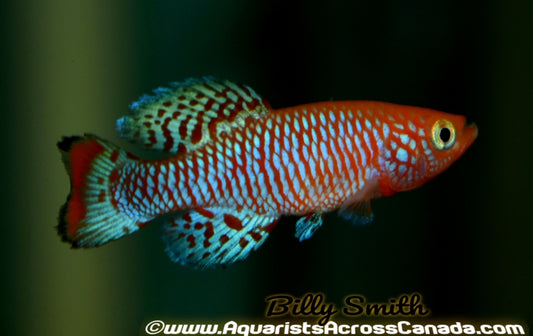Collection: KILLIFISH
Killifish are not well known in the mainstream aquarium hobby and are seldom seen in local fish stores, but they are some of the most colorful freshwater aquarium fish in existence. Members of the family Cyprinodontidae, these distant relatives of mollies, guppies, swordtails and platies are known collectively as egg laying tooth carp. Most are small – 1” to 2” – with the largest species growing to less than 6 inches. Most killifish live 2 to 5 years in aquariums.
Perhaps the most fascinating thing about killifish is their different spawning methods, which separate them into three basic groups: annuals, semi-annuals and non-annuals. In the wild, annuals live in temporary pools that dry up each year for periods up to 6 months. They hatch, grow, reproduce and die all in less than a year and their eggs go dormant until the next rainy season. Semi-annuals inhabit areas that may or may not dry up completely, while non-annuals occupy permanent bodies of water. Keeping killifish ranges from easy to difficult, depending on species. While they do have a few special requirements, if you’re looking for something a little different, killifish are well worth the effort!
Many killifish are perfect for nano and desktop aquariums because of their small size. For species tanks, a trio can be housed in 5 to 10 gallons, but a 20 gallon or larger aquarium is recommended for community setups or if you want to keep more than one male. Lighting should be subdued and non-breeding tanks should be decorated with driftwood or peat moss to help soften the water and lower pH, along with low light tolerant plants such as Cryptocorynes, Java moss and Java fern. For filtration, a small sponge filter with gentle air flow is recommended. Killifish are accomplished jumpers, so a tight fitting lid is a must!
Killifish are, by and large, carnivores. Depending on the size of your fish, frozen foods such as brine shrimp, newly hatched brine shrimp nauplii, daphnia, mysis shrimp, mosquito larvae and bloodworms are all good choices. Killifish have a reputation of refusing dry foods, but many hobbyists have had success with them.
-
CLOWN KILLIFISH (Epiplatys annulatus)
Regular price $7.99 CADRegular priceUnit price / per$9.49 CADSale price $7.99 CADSold out -
GOLDEN PANCHAX KILLIFISH (Aplocheilus lineatus)
Regular price $8.99 CADRegular priceUnit price / per$11.99 CADSale price $8.99 CADSale -
NORMANS LAMPEYE KILLIFISH (Poropanchax normani)
Regular price $5.24 CADRegular priceUnit price / per$6.99 CADSale price $5.24 CADSold out -
DAISY'S BLUE RICE FISH (Oryzias latipes)
Regular price $9.99 CADRegular priceUnit price / per -
BLACK MEDAKA RICE FISH (Oryzias latipes)
Regular price $12.99 CADRegular priceUnit price / per -
NOTHO KILLIFISH (Nothobranchius rachovi)
Regular price $19.99 CADRegular priceUnit price / per






